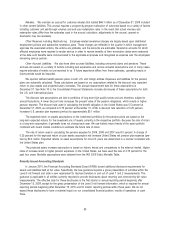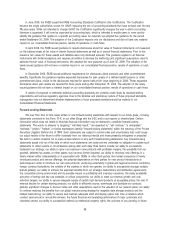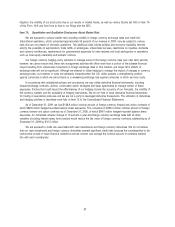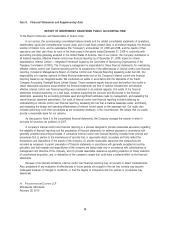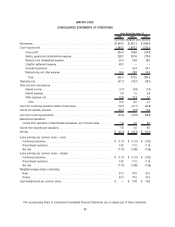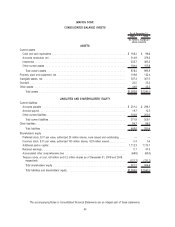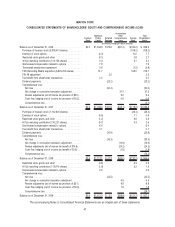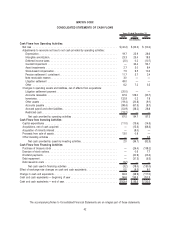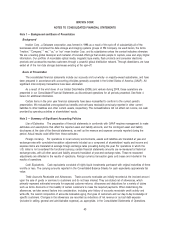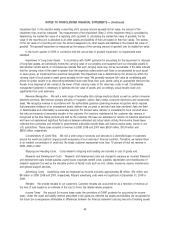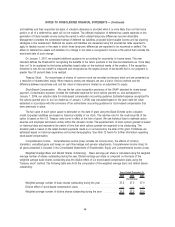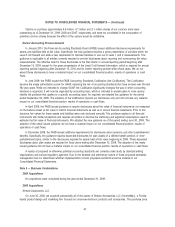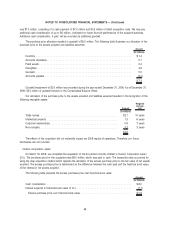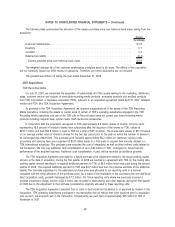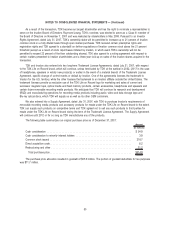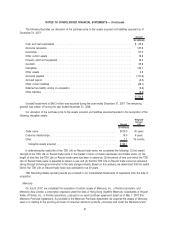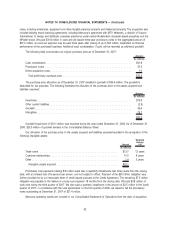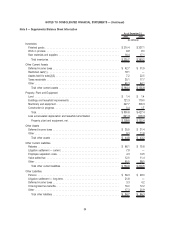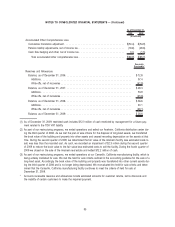Memorex 2009 Annual Report Download - page 52
Download and view the complete annual report
Please find page 52 of the 2009 Memorex annual report below. You can navigate through the pages in the report by either clicking on the pages listed below, or by using the keyword search tool below to find specific information within the annual report.impairment test. In the situation where a reporting unit’s carrying amount exceeds its fair value, the amount of the
impairment loss must be measured. The measurement of the impairment (Step 2 of the impairment test) is calculated by
determining the implied fair value of a reporting unit’s goodwill. In calculating the implied fair value of goodwill, the fair
value of the reporting unit is allocated to all other assets and liabilities of that unit based on their fair values. The excess
of the fair value of a reporting unit over the amount assigned to its other assets and liabilities is the implied fair value of
goodwill. The goodwill impairment is measured as the excess of the carrying amount of goodwill over its implied fair value.
In the fourth quarter of 2009, in connection with the annual test of goodwill impairment, no impairments were
identified.
Impairment of Long-Lived Assets. In accordance with GAAP guidance for accounting for the impairment or disposal
of long-lived assets, we periodically review the carrying value of our property and equipment and our intangible assets to
test whether current events or circumstances indicate that such carrying value may not be recoverable. If the tests indicate
that the carrying value of the asset is greater than the expected undiscounted cash flows to be generated by such asset
or asset group, an impairment loss would be recognized. The impairment loss is determined by the amount by which the
carrying value of such asset or asset group exceeds its fair value. We generally measure fair value by considering sale
prices for similar assets or by discounting estimated future cash flows from such assets using an appropriate discount rate.
Assets to be disposed of are carried at the lower of their carrying value or fair value less costs to sell. Considerable
management judgment is necessary to estimate the fair value of assets and, accordingly, actual results could vary
significantly from such estimates.
Revenue Recognition. We sell a wide range of removable data storage media products as well as certain consumer
electronic products. Net revenue consists primarily of magnetic, optical, flash media, consumer electronics and accessories
sales. We recognize revenue in accordance with the authoritative guidance governing revenue recognition which requires
that persuasive evidence of an arrangement exists, delivery has occurred or services have been rendered, fees are fixed
or determinable and collectability is reasonably assured. For product sales, delivery is considered to have occurred when
the risks and rewards of ownership transfer to the customer. For inventory maintained at the customer site, revenue is
recognized at the time these products are sold by the customer. We base our estimates for returns on historical experience
and have not experienced significant fluctuations between estimated and actual return activity. Non-income based taxes
collected from customers and remitted to governmental authorities include levies and various excise taxes, mainly in non
U.S. jurisdictions. These taxes included in revenue in 2009, 2008 and 2007 were $50.9 million, $75.9 million and
$69.8 million, respectively.
Concentrations of Credit Risk. We sell a wide range of products and services to a diversified base of customers
around the world and perform ongoing credit evaluations of our customers’ financial condition. Therefore, we believe there
is no material concentration of credit risk. No single customer represented more than 10 percent of total net revenue in
2009, 2008 or 2007.
Shipping and Handling Costs. Costs related to shipping and handling are included in cost of goods sold.
Research and Development Costs. Research and development costs are charged to expense as incurred. Research
and development costs include salaries, payroll taxes, employee benefit costs, supplies, depreciation and maintenance of
research equipment as well as the allocable portion of facility costs such as rent, utilities, insurance, repairs, maintenance
and general support services.
Advertising Costs. Advertising costs are expensed as incurred and were approximately $6 million, $14 million and
$9 million in 2009, 2008 and 2007, respectively. Prepaid advertising costs were not significant at December 31, 2009 or
2008.
Rebates. We provide rebates to our customers. Customer rebates are accounted for as a reduction of revenue at
the time of sale based on an estimate of the cost to honor the related rebate programs.
Income Taxes. We account for income taxes under the provisions of GAAP guidance for accounting for income
taxes. Under the asset and liability method prescribed in the guidance, deferred tax assets and liabilities are recognized for
the future tax consequences attributable to differences between the financial statement carrying amounts of existing assets
45
NOTES TO CONSOLIDATED FINANCIAL STATEMENTS — (Continued)


